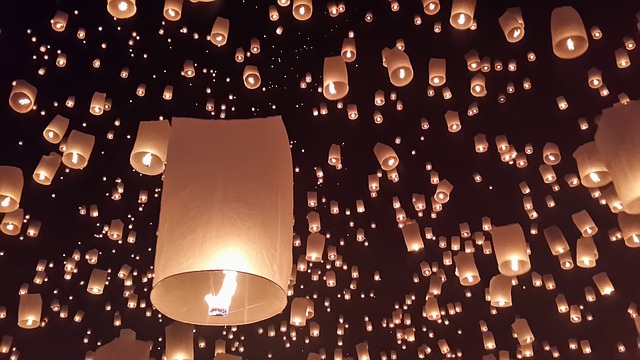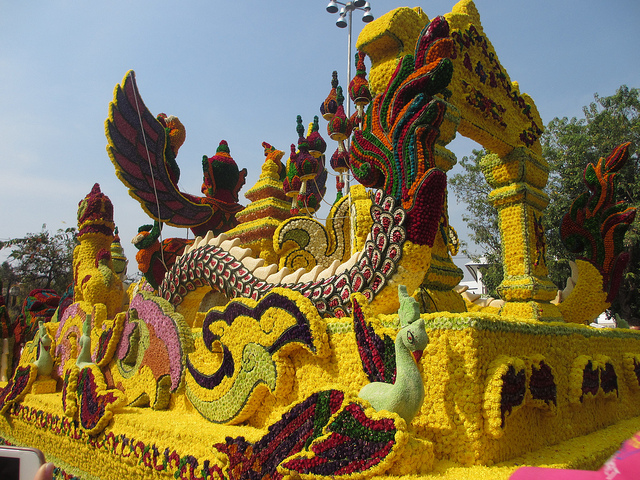
This article first appeared on International Living Australia
An increasing number of Aussies are calling Thailand home. The low cost of living, first class healthcare, great food and rich culture are luring expats in droves. If a move is on the cards but you’re thinking of test-driving a retirement overseas first, Thailand’s Chiang Mai is a great spot to do so.
Numerous festivals and events run throughout the year. Whether it’s the over-the-top Songkran water festival, the beautiful February Flower festival or Chinese New Year, the Thai people certainly know how to party and celebrate.
Here are five times to visit Chiang Mai and one to avoid…
1. Loy Krathong and Yee Ping
Things swing into gear in November with Loy Krathong and Yee Ping. These two important celebrations coincide with the full moon of the twelfth Thai month. Yee Ping is celebrated throughout northern Thailand and everywhere in Chiang Mai you will see colourful lanterns decorating homes, businesses, temples and public spaces.
As part of the festival there are activities including traditional Thai dance shows and the official Yee Ping parade with the beauty pageant for the crowning of Miss Yee Ping. However, the highlight is the one night when the sky is filled with khom loi (sky lanterns). These are released into the skies and symbolise letting go of all ills and misfortunes of the previous year and to bring good luck.
2. Chiang Mai University Graduation
In the middle of January, the Chiang Mai University (CMU) students graduate. CMU is huge and is nestled between the trendy Nimman area and the base of the nearby mountain, Doi Suthep.
CMU’s large campus has its own fleet of electric buses that ferry the students around the campus and compete with the myriad of scooter riding undergraduates. The graduation celebrations are accompanied by areas specially planted out with flowers in full bloom. The graduates and their families happily pose together amongst the tall hollyhocks, sun flowers and cosmos.
3. The Chiang Mai Flower Festival
Not long after graduation, on the first weekend in February, the Chiang Mai Flower Festival swings into gear. Non Buak Hard Public Park inside the old city is transformed with fantastic floral displays, orchid houses, bonsai and all manner of floral arrangements and displays.
The highlight is the parade on the Saturday morning when multitudes of motorised floats make their way around the town. Interspersed between the colourful floats are bands and community groups, many dressed in traditional costumes. The floats are something to behold and represent many facets of Thai life and culture.
Photo by eltpics on Flickr
4. Chinese New Year
Later in February China Town becomes the focus of attention with Chinese New Year festivities. It is transformed with traditional red lanterns stretching across all the streets surrounding Warorot Market next to the Mae Ping River. Food features heavily during this festival with crowded street markets selling all manner of Thai and Chinese specialities.
A number of stages are also erected throughout the festival area where you can be entertained, day and night, with various performances.
Of course, Chinese New Year would not be complete without crackers and fireworks which all add to the celebratory atmosphere.
5. Songkran
April marks one of the most important events on the Buddhist calendar. April 13th is Thai New Year’s Day, known locally as ‘Songkran’. There are deep religious roots associated with this festival including making merit and visiting local temples with food offerings for the Buddhist monks.
Pouring water on Buddha statues, the young and elderly, represents purification and the washing away of one’s sins and bad luck. Whilst these traditions are still observed it has morphed into an ongoing party through all the streets with locals and tourists alike drenching each other in water. Whether it be via water pistol, super soaker or a plain old bucket, you are not safe from a drenching anywhere during this period. Happily, as it’s one of the hottest times of the year nobody seems to mind and it’s all done in good spirit.
Whereas Hua Hin may celebrate for one day and Bangkok for three days, Chiang Mai is the epicentre for Songkran celebrations that continue for five days. It really is a fun time of the year.
And One to Avoid…
The one time of the year that expats opt for a temporary change of location from Chiang Mai is from late February. This coincides with the start of what is known locally as the “burning / smoky” season. Farmers commence the traditional practice of burning the rice stubble from the previous harvest in preparation for the next growing season where the ash provides excellent fertiliser for the rice paddies. The downside is the smoke impacts upon the air quality and a dingy haze falls, obscuring the city’s views. As a result, many expats choose this time of year to take advantage of the host of low cost travel options in Thailand and jet off to explore pastures new.

{ 0 comments… add one now }